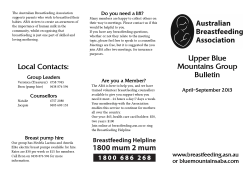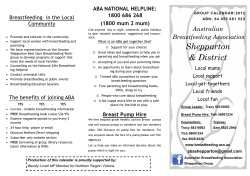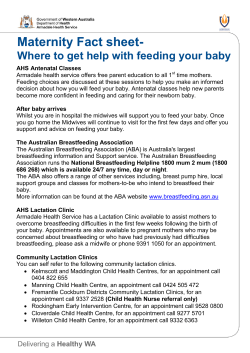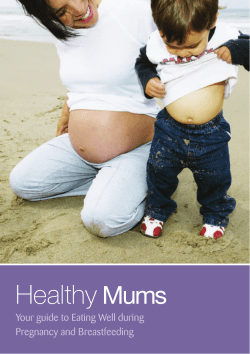
P Nutritional Needs of Pregnancy and Breastfeeding Family and Consumer Sciences
Family and Consumer Sciences HYG-5573-09 Nutritional Needs of Pregnancy and Breastfeeding P regnancy and breastfeeding are the most nutritionally demanding times of a woman’s life. The body needs enough nutrients every day to support the growth of the baby and the maintenance of the mother’s body. All the nourishment this developing baby needs comes from mom, either through the foods she eats or the supplements she takes. Pregnant and lactating women need more essential nutrients than other women. The body needs an additional 300 calories each day to support the growth of the baby. It is important to eat the right foods every day since tissues and organs develop during certain weeks of your pregnancy and the baby is always growing. Mom’s health depends on diet, too. While the mother’s body is supplying the nutrients the baby needs, her body still needs the same nutrients as before she was pregnant. MyPyramid Plan for Moms has recommendations for pregnancy and breastfeeding (http:// www.mypyramid.gov/mypyramidmoms/). The recommendations help moms choose healthy foods to meet their needs. Increase the intake of nutrient-dense foods. Nutrient-dense foods are packed with more nutrients for the calories than other foods that are mostly calories with few other nutrients. Nutrients are also called vitamins and minerals. By following the MyPyramid Plan for Moms recommendations, mom can get the nourishment she needs. Personal daily needs will vary depending on the mother’s weight before pregnancy, activity level, and if mom is expecting or has delivered multiple babies. Moms should discuss what and how much to eat with a health care provider. Protein is needed for the buildup of your muscles, uterus, breasts, blood supply, and baby’s tissues. Low protein intake is related to smallerthan-average weight babies who may have health problems. Pregnant and breastfeeding women need around 71 grams of protein per day. Folate is a vitamin that is required to build protein tissues. Low folate levels are linked to birth defects, such as spina bifida. These defects form early in pregnancy, often before women know they are pregnant. It is important to eat enough foods high in folate like broccoli, dark green vegetables, and oranges both before and during pregnancy. The dietary reference intake for folate is 400 micrograms per day before pregnancy, 600 micrograms per day during pregnancy, and 500 micrograms per day while breastfeeding. Copyright © 2009, The Ohio State University Nutritional Needs of Pregnancy and Breastfeeding—page 2 Calcium is needed by your baby for strong bones. If calcium is not supplied by the mother’s diet, calcium is taken from the mother’s bones for the baby. Pregnant and breastfeeding women 19 and older need around 1,000 milligrams per day or 1,300 milligrams per day for women under 19 years of age. Low zinc levels during pregnancy can cause long labor and small babies who may have health problems. The dietary reference intake for zinc is 11 milligrams per day or 12 milligrams per day for women under 19 years of age. Women who are breastfeeding need about the same amount (12 milligrams per day or 13 milligrams per day for women under 19). Iron deficiency is common in pregnant women. Both mother and baby need iron for their developing blood supplies. A developing baby also stores iron for use after birth. This increases the mother’s iron needs. It is practically impossible to get enough iron from food. Doctors usually recommend supplements. All pregnant women need around 27 milligrams per day. The need for iron declines after birth but women who are breastfeeding still require about 10 milligrams a day. A good diet takes planning. Pregnant women should make sure to include: •Enough calories for adequate weight gain. •A variety of foods from each food group, with limited use of the oils and solid fats group. •Regular meals and snacks. •30 grams of dietary fiber every day—reach this goal by eating whole grains, fruits, and vegetables. •8 or more cups of water each day. •Salt to taste. •No alcoholic beverages, including beer. •Prenatal vitamin once a day, if prescribed by your doctor. No one can guarantee a baby will be born healthy and strong. However, these are steps mothers-to-be can take to make the best baby possible. Nothing offers greater benefits to mother and baby than good nutrition. Weight Before Pregnancy Suggested Weight Gain Normal Weight (BMI 20–24) 25–35 pounds Underweight (BMI < 20) 28–40 pounds Overweight (BMI 25–29) 15–25 pounds Very Overweight (BMI > 30) ~15 pounds Guide to Good Eating During Pregnancy and Breastfeeding Tips to Remember: •Eat a variety of foods. •Choose foods with a lot of fiber—fruits, vegetables, dry beans, whole grain breads and cereals, and other whole grain products. •Exercise in moderation on a regular basis (ask your doctor). •Drink plenty of fluids (64 ounces per day or eight 8-ounce glasses). •Eat 3 to 5 meals and snacks per day. •Pregnancy and breastfeeding increase the need for calories and most nutrients. A women who is pregnant or breastfeeding needs to eat 300 more calories to provide the extra energy the body needs. Remember, this is not a lot of food. Three hundred calories is equal to a small snack, such as a half of a peanut butter and jelly sandwich and a glass of 1% milk. •The amount of suggested weight gain during pregnancy depends upon weight before pregnancy. Check with a doctor to find the amount that is right for you. Copyright © 2009, The Ohio State University Nutritional Needs of Pregnancy and Breastfeeding—page 3 •While nursing, avoid restrictive weight loss diets. Losing 2–4 pounds a month will not affect your milk supply, but losing more than 4–5 pounds a month after the first month is not recommended. •Visit MyPyramid online at www.mypyramid. gov/mypyramidmoms/ for more information. Recommended Servings Recommended servings are based on a 2000 calorie diet. A pregnant or lactating woman’s needs may vary depending on age, sex, and activity level. Milk Group—3 cups per day; be sure to choose lower fat selections. Count as 1 cup: 1 cup (8 ounces) 1% or skim milk; 1 cup low-fat yogurt; 2 cups low-fat or fat-free cottage cheese; 1½ cups low-fat or fatfree ice cream; 1½ ounces of low-fat hard cheese (cheddar, mozzarella, Swiss, or parmesan); 1/3 cup shredded cheese; 2 ounces processed cheese (American); 1 cup pudding (made with milk). Meat and Beans Group—5.5 ounce equivalents (or the amount of a food that has a similar nutrition value as 5.5 ounces of meat). Count as 1 ounce equivalent: 1 ounce lean meat, fish, or poultry; 1 egg; 1 slice lunch meat; 1 tablespoon peanut butter; 1/4 cup cooked kidney, pinto, or garbanzo beans, or 1/2 ounce of nuts or seeds. Fruit Group—2 cups. Count as 1 cup: 1 cup (8 ounces) 100% juice; 1 large banana or orange; 1 small apple; 1 cup canned fruit. Include one Vitamin C source such as an orange or orange juice every day. Vegetable Group—2.5 cups. Count as 1 cup: 1 cup cooked vegetables; 2 cups raw leafy vegetables; 1 cup (8 ounces) 100% juice. Include one serving of a dark green leafy vegetable every day. Grain Group—6 ounce equivalents (or the amount of a food that has a similar nutrition value to 6 ounces of a grain). Count as 1 ounce equivalent: 1 slice bread; 1 cup ready-to-eat cereal; 1/2 cup cooked cereal, rice, or pasta, 1/2 “mini” bagel, 1 small tortilla, 6 inches in diameter; 1 pancake, 4½ inches in diameter. Oils—6 teaspoons. Common portions: 1 tablespoon oil = 3 tsp; 1 tablespoon margarine = 2.5 tsp; 1 tablespoon mayonnaise = 2.5 tsp; 1 ounce nuts = 3 tsp; 2 tablespoons salad dressing = 2 tsp; 1/2 Avocado = 3 tsp; and 4 large olives (0.5 tsp). Most cakes, pies, cookies, soft drinks, sugar, honey, candy, jams, jellies, gravies, butter, and sour cream have either an oil or solid fat and may be loaded with simple sugars. Eat them in moderation; save them to eat only if you need extra calories after eating the basic needed foods. MyPyramid A Guide to Daily Food Choices When Pregnant or Breastfeeding Oils Milk, Yogurt, and Cheese (Milk) Group Vegetable Group Meat, Poultry, Fish, Dry Beans, Eggs, and Nuts (Meat and Beans) Group Fruit Group Grain Group 6 teaspoons 3 cups 2.5 cups 5.5 ounce equivalents 2 cups 6 ounce equivalents References Panel on Micronutrients, Subcommittees on Upper Reference Intakes of Nutrients and of Interpretation and the Uses of Dietary Reference Intakes, and the Standing Committee on Copyright © 2009, The Ohio State University Nutritional Needs of Pregnancy and Breastfeeding—page 4 the Scientific Evaluation of Dietary Reference Intakes. (2001). Dietary Reference Intakes for Calcium, Phosphorus, Magnesium, Vitamin D, and Fluoride. Washington, DC: National Academies Press. Panel on Macronutrients, Panel on the Definition of Dietary Fiber, Subcommittee on Upper Reference Levels of Nutrients, Subcommittee on Interpretation and Uses of Dietary Reference Intakes, and the Standing Committee on the Scientific Evaluation of Dietary Reference Intakes, Food and Nutrition Board. (2005). Dietary Reference Intakes for Energy, Carbohydrate, Fiber, Fat, Fatty Acids, Cholesterol, Protein, and Amino Acids. Washington, DC: National Academies Press. Panel on Micronutrients, Subcommittees on Upper Reference Intakes of Nutrients and of Interpretation and the Uses of Dietary Reference Intakes, and the Standing Committee on the Scientific Evaluation of Dietary Reference Intakes. (1998). Dietary Reference Intakes for Thiamin, Riboflavin, Niacin, Vitamin B6, Folate, Vitamin B12, Pantothenic Acid, Biotin, and Choline. Washington, DC: National Academies Press. Panel on Micronutrients, Subcommittees on Upper Reference Intakes of Nutrients and of Interpretation and the Uses of Dietary Reference Intakes, and the Standing Committee on the Scientific Evaluation of Dietary Reference Intakes. (2000). Dietary Reference Intakes for Vitamin A, Vitamin K, Arsenic, Boron, Chromium, Copper, Iodine, Iron, Manganese, Molybdenum, Nickel, Silicon, Vanadium, and Zinc. Washington, DC: National Academies Press. The National Women’s Health Information Center. (2005). Pregnancy and a Healthy Diet. Retrieved June 1, 2005 from: www.4women.gov. U.S. Department of Agriculture. (2005). MyPyramid. Retrieved June 2005 from: www. mypyramid.gov. Updated by Julie Shertzer, Program Specialist, Human Nutrition, July 2008. Original author: Jaime Foster, Extension Associate, Human Nutrition. Visit Ohio State University Extension’s web site “Ohioline” at: http://ohioline.osu.edu Ohio State University Extension embraces human diversity and is committed to ensuring that all research and related educational programs are available to clientele on a nondiscriminatory basis without regard to race, color, religion, sex, age, national origin, sexual orientation, gender identity or expression, disability, or veteran status. This statement is in accordance with United States Civil Rights Laws and the USDA. Keith L. Smith, Ph.D., Associate Vice President for Agricultural Administration and Director, Ohio State University Extension TDD No. 800-589-8292 (Ohio only) or 614-292-1868 Copyright © 2009, The Ohio State University
© Copyright 2025





















